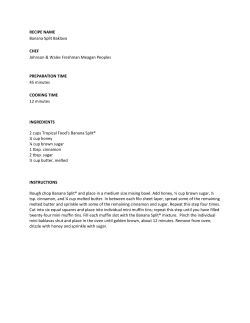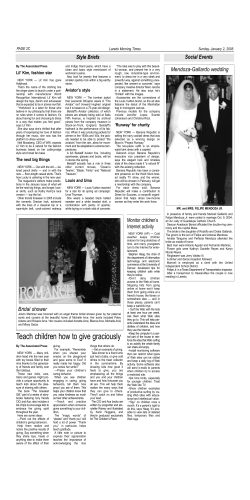
MEDIA RELEASE
MEDIA RELEASE October 10, 2014 NEW PHASE FOR FRECKLE ERADICATION PROTECTS AUSTRALIAN BANANA INDUSTRY One of the most significant pest eradication efforts in Australia will enter a new phase after the approval of a plan to rid the nation of one of the world’s worst banana diseases, Banana Freckle (Phyllosticta cavendishii). It was today announced approval had been granted by a national industry and government biosecurity group for a Northern Territory (NT) eradication plan that will continue eradication work which began there a year ago. The estimated cost of the four-year eradication, including the work already completed, is estimated at about $26 million. Eradication work began last October after freckle was first found on Cavendish banana plants in rural-residential backyards, near Darwin in July 2013. The fungal disease causes dark, raised blemishes on banana plants and fruit. It is hoped work to show freckle has been eradicated can begin in April 2017 and quarantine restrictions can be lifted when proof of freedom from the disease has been established. Australian Banana Growers’ Council (ABGC) Chairman Doug Phillips said approval of the new eradication plan was a win for the Australian banana industry which faced substantial damage if the disease spread from the NT into major growing regions. “Banana Freckle is one of the world’s worst banana diseases and this new eradication plan is necessary to protect Australia’s banana industry and its $600 million annual production,” Mr Phillips said. “Since Banana Freckle was first detected in the Territory on Cavendish bananas in July 2013, the banana industry and government have been working together to eradicate the disease and develop a plan to rid the Territory of this disease and safeguard the national banana industry. “It’s positive news for the Australian banana industry that the eradication work can now continue under a new, stronger response plan. It will also help protect the longer-term future of both the commercial banana industry that remains in the Territory as well as backyard banana growing there.” Commercial banana production in the NT has already been severely reduced in recent years by the soil-borne disease Panama Tropical Race 4 (TR4) which kills banana plants and cannot be eradicated. The NT is the only known Australian location of TR4. The eradication response is being conducted by the NT under the Emergency Plant Pest Response Deed. This Deed is the agreement between the Australian Government, all state and territory governments, most plant industries and Plant Health Australia to manage emergency plant pests. The Australian Banana Growers’ Council (ABGC) and Nursery & Garden Industry Australia (NGIA) are signatories to the Deed. Continues Unit 3, South Gate East Commercial Centre 250 Sherwood Road ROCKLEA QLD 4106 PO Box 309 BRISBANE MARKET QLD 4106 Tel: 07 3278 4786 Fax: 07 3278 4938 Web: www.abgc.org.au MEDIA RELEASE Mr Phillips said the ABGC, on behalf of the banana industry, signed the Deed in 2005. It ensures Federal, Territory and State governments and industry can jointly fund emergency plant pest eradications. Main details of the new Banana Freckle eradication plan are: new three-year plan to eradicate Banana Freckle (Phyllosticta cavendishii) from Australia with work beginning in October 2014 and proof of freedom to be established from April 2017 total cost of eradication, including work already conducted, is estimated at about $26 million and will be jointly funded by banana growers, the nursery industry, NGIA and Commonwealth, State and Territory governments the cost-shared amount of the eradication will be about $21 million and the NT Government will provide an additional amount of about $4.8 million commercial banana growers’ contribution to be finalised but expected to be about half the costshare amount, in the range of $10 million to $13 million all banana plants to be removed from six eradication zones – the Greater Darwin area; Rum Jungle and Batchelor, south of Darwin; Dundee Beach, south west of Darwin; Nauiyu/Daly River, south west of Darwin; Milikapiti on Melville Island; and the Ramingining Aboriginal community in west Arnhem Land a four-phase approach of removing banana plants in the eradication zones; a banana plantfree period including a full wet season; controlled reintroduction and monitoring of banana plants and assessment of freedom from the pest movement controls for banana plants and fruit Owner Reimbursement Costs for affected commercial banana growers and production nurseries. Banana grower contributions will be made over a number of years via a production-based levy to be activated under the terms of a joint Federal Government and industry Emergency Plant Pest Response (EPPR) Deed. Mr Phillips said growers would soon be provided with information and consulted on the structure of the levy and the costs involved. He said the new Response was approved after eradication was found to be technically feasible by a group of expert government and industry advisors who formed a Consultative Committee on Emergency Plant Pests (CCEPP). It is the first banana industry pest response under the EPPR Deed and one of the first uses of the Deed in Australian horticulture. A benefit-cost analysis by the Australian Bureau of Agricultural and Resource Economics and Sciences concluded it was economically beneficial and feasible to eradicate freckle. A separate government and industry group overseeing the eradication, the National Management Group approved the plan after assessing the CCEPP’s findings. Continues Unit 3, South Gate East Commercial Centre 250 Sherwood Road ROCKLEA QLD 4106 PO Box 309 BRISBANE MARKET QLD 4106 Tel: 07 3278 4786 Fax: 07 3278 4938 Web: www.abgc.org.au MEDIA RELEASE A State Control Centre and Local Control Centre will be established to conduct the eradication and an Incident Management Team will be recruited. To date, the NT Department of Primary Industry & Fisheries (DPI&F), has conducted a range of work needed for eradication. The latest findings are that there are 58 infected properties where Banana Freckle is on Cavendish bananas and a further 185 properties where it is on Lady Finger bananas. Over the past year, the NT DPI&F has conducted more than 30,000 property visits and compiled extensive maps of banana plant locations. About Banana Freckle Banana Freckle (Phyllosticta cavendishii) reduces banana plant yield by damaging plant leaves which yellow and die. Visible signs are small spots or streaks which have a sandpaper feel and appear on the leaves of banana plant as well as on the skins of the fruit. While fruit affected by Banana Freckle is safe to eat, the appearance of the fruit makes it unsaleable. Banana Freckle is found in parts of Asia and the Pacific Islands. It is considered to be one of the world’s worst banana diseases. It is not known how the disease arrived in the NT but it moves in spores carried in water splashes and potentially by wind-borne spores. It is also transmitted by the movement of infected banana plants and fruit. The disease spreads rapidly in wet tropical conditions, such as those in Australia’s main banana growing regions in north Queensland. Little was known about the disease prior to the NT outbreak, although the banana industry has conducted research in recent years which produced some breakthrough findings. More research has been conducted over the past year. For more information: Rhyll Cronin Communications Manager Tel: 07 3278 4786 Mob: 0428 038 330 Unit 3, South Gate East Commercial Centre 250 Sherwood Road ROCKLEA QLD 4106 PO Box 309 BRISBANE MARKET QLD 4106 Tel: 07 3278 4786 Fax: 07 3278 4938 Web: www.abgc.org.au
© Copyright 2025












